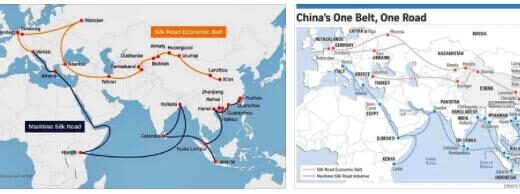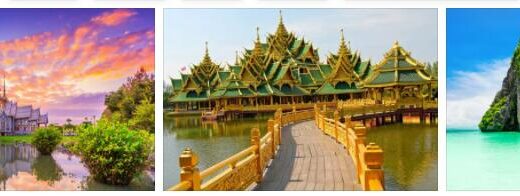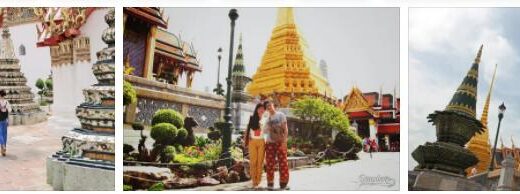Thailand Ecological Problems
Thailand is naturally shaped by the plain north of the capital Bangkok, extensive mountain ranges in the north, west and center, the plateau in the northeast, and the Ithmus of Kra in the south. The rivers that feed the mighty Chao Praya River of the lowlands have their source in the mountains of the north. In the dry northeast, the Mun and Chi flow into the Mekong. The hydrography is also influenced by the monsoonal climate, which causes a rainy season from April to October and a dry season from November to April. The climate is therefore tropical-monsoonal. The south is tropical and characterized by the long coast, karst mountains and many islands. Thailand is a center of biological diversity, with an enormous range of different forest types, around 25,000 plant species and an estimated 60,000 undiscovered animal species. In the many national parks you can visit the different natural spaces and ecosystems. World Heritage Sites such as the Dong Phayayen-Khao Yai Forest or the Thungyai-Huai Kha Kaen Game Reserve show still intact forest complexes. Thailand also has a number of natural resources including coal and oil, especially known for tin.
Ecological problems
The rapid industrialization of Thailand has created a number of environmental problems. Wastewater from industrial plants pollutes the Chao Praya, for example, while exhaust gases and traffic impair the air quality and create a fine dust problem in Bangkok and other cities. Even if there has been progress in environmental legislation – especially with regard to exhaust gases and waste management – large wastewater treatment projects like the one in Samut Prakan are still controversial.
In rural areas, high deforestation rates endanger biodiversity, tourism industry and shrimp farming endanger the mangroves and coastal areas. Major ecological interventions such as the attempted establishment of eucalyptus plantations for the pulp industry, dams such as the Pak Mun or lignite power stations such as Mae Moh led to violent socio-ecological disputes.
Two water disasters were even more dramatic: the 2004 tsunami and the great Bangkok flood in 2011. Southern Thailand in particular was hit by the tsunami, many thousands of people drowned. The effects of both disasters have been aggravated by man-made environmental changes in the preceding years, and the sometimes inadequate reaction of the authorities generated strong political discussions.
A complex environmental movement has emerged in Thailand since the 1980’s. The Forum of the Poor, founded in 1995, opposed the consequences of industrial development and advocated ecological agriculture. The decades-long movement against the Pak Mun Dam has in turn prevented the further expansion of large hydroelectric plants. For the goal of climate justice, a broad alliance of civil society actors has come together in the Thai Working Group for Climate Justice (TCJ). The Fridays for Future movement has also become active in Bangkok. Concrete projects such as the reforestation of mangrove forests on the island of Kho Klang, show that a more sustainable approach can work.
Although Thailand is a signatory to important conventions such as the Convention on Biological Diversity and the Climate Change Convention, the Thai government reacted defensively or even repressively to these movements. The Ministry of Natural Resources and Environment was only established in 2002. A lot is promised in climate policy, but implementation is a long time coming. The forest administration, formerly denounced for its joint responsibility for the deforestation of the Thai forests, tries again and again to drive indigenous people out of national parks. Since the military coup of 2014 there has been tougher against land occupations proceeded. The military regime wants to increase the forest area to 40% through evictions. In 2018, farmers protested against the new forest policy by marching to Bangkok in a “We Walk” campaign. Environmental activists are repeatedly killed, such as the anti-coal mining activist Pithan Thongpanang, who was shot dead on the street in December 2014. In 2016, land rights activist Chai Bunthonglek was murdered in southern Thailand. In 2017 a soldier shot and killed Chaiyaphum Pasae, an activist of the “Indigenous Peoples Human Rights Defender” and co-founder of the “Save Lahu” group.
Forest under military rule
Since the coup in 2014 there has been a remilitarization of forest policy in Thailand. Shortly after the coup, the junta presented a new forest strategy aimed at violent re-territorialization of the forests. People who live in forest areas are threatened with resettlement. As is very often the case in Thai forest policy, state control over forests is justified at the expense of small farmers with ambitious reforestation plans. As in previous projects, the collaboration between the Royal Forestry Department and the Counterinsurgency Operations Command (ISOC)conspicuous, as is the name of the program, the “Forestry Master Plan”. A new edition of the Community Forestry Bill, which was passed in early 2019, prohibits the use of community forests in protected forest areas. The law is thus a de facto expropriation of many ethnic minorities who have been using and protecting forest areas in the national parks for decades. Military interference in forest policy is flanked by repression and the murder of political activists. Similar approaches in Thai forest policy were previously repeatedly prevented by movements of civil disobedience and by forest monks.



